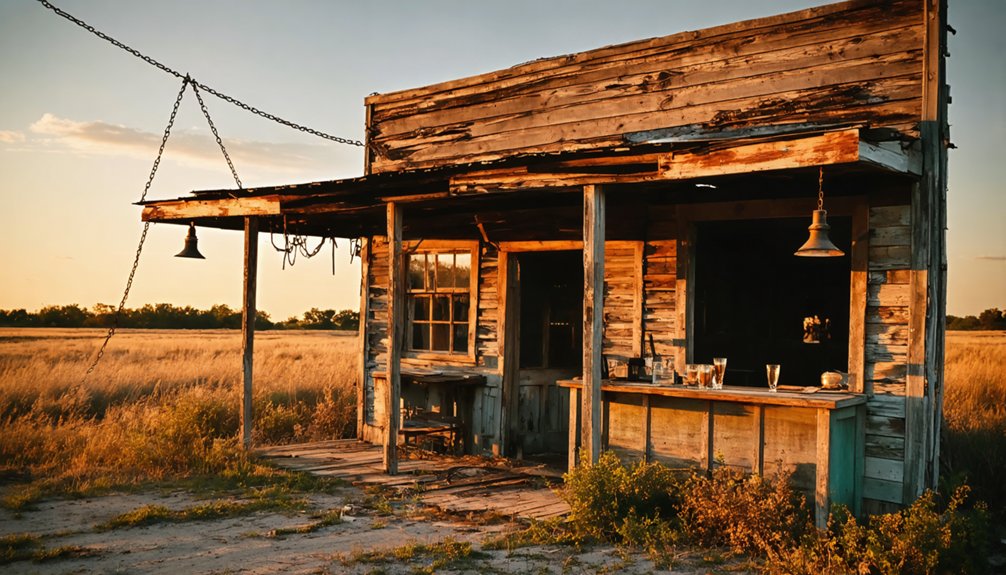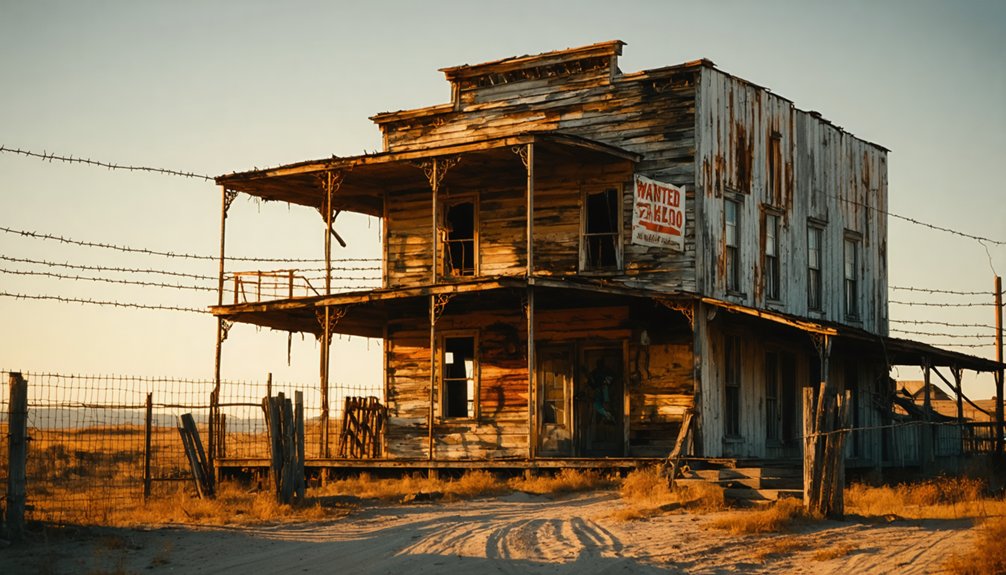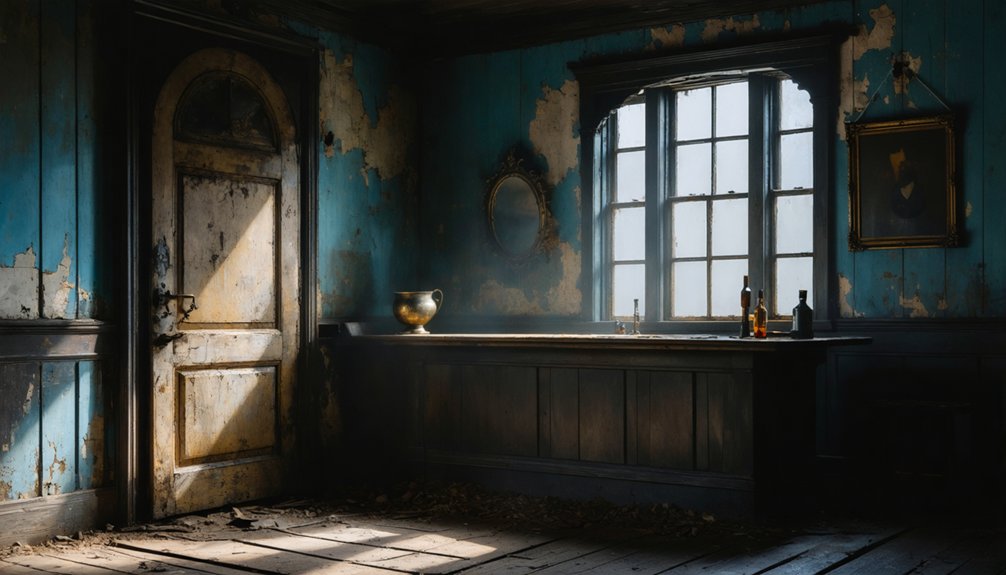When exploring Texas ghost town churches, you’ll discover weathered sanctuaries like St. Dominic’s with its 1853 gravity-supported arches or Sacred Heart in Shafter with its mining heritage. These abandoned structures showcase Gothic elements, adobe construction, and adjacent historic cemeteries dating to the 1840s. Always obtain proper permissions and observe safety precautions around deteriorating structures. The silent bell towers and crumbling walls reveal profound stories of frontier faith and community perseverance.
Key Takeaways
- Abandoned churches like St. Dominic’s and Sacred Heart reveal Texas frontier history through architectural styles and cemetery narratives dating to the 1840s.
- Obtain explicit permission before accessing churches on private property and research ownership status to avoid trespassing violations.
- Prepare for exploration with proper vehicles, safety equipment, and awareness of structural hazards and wildlife encounters.
- Document visits respectfully, following Leave No Trace principles while exploring sites like Belle Plain College with its Baptist heritage.
- Engage with local historical societies to contribute to preservation efforts of these endangered cultural landmarks.
The Sacred Ruins of St. Dominic’s Catholic Church
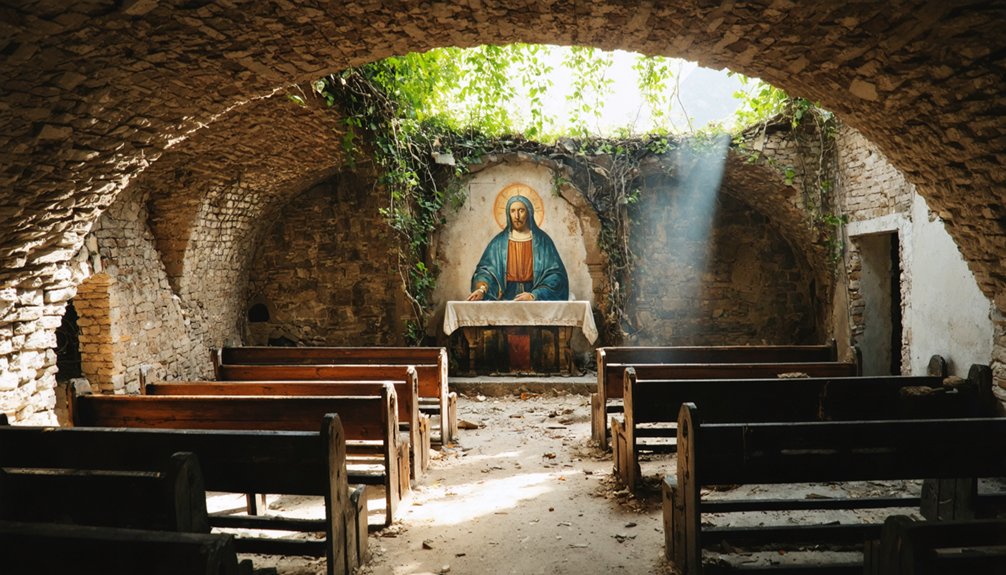
Standing as a tribute to Texas’s Alsatian immigrant heritage, St. Dominic’s limestone remains offer a compelling ruins exploration opportunity near Old D’Hanis. Founded in 1847 and rebuilt in 1853, the church was abandoned when the railroad shifted the town westward. After a 1912 fire, the congregation relocated entirely.
You’ll find the ruins at County Roads 5226 and 5231, where massive limestone blocks with visible chisel marks form gravity-supported arches with ornate keystones. The site exemplifies historical preservation challenges as nature reclaims the structure—cacti grow among stones once covered with plaster and lime wash. The ruins create a somber atmosphere that encourages visitors to reflect on the area’s religious past. Located approximately forty miles west of San Antonio, this historical site makes for an ideal quick stop during day trips in the region.
Adjacent to the cemetery with graves dating to the 1840s, this National Register site provides a window into the European settlement patterns that shaped Texas’s cultural landscape.
Forgotten Faith in Presidio County: Shafter’s Resilient Church
While limestone ruins dominate the immigrant-influenced landscapes of eastern Texas ghost towns, adobe structures tell different stories in the state’s western reaches.
Sacred Heart Church (Sagrado Corazon), built in 1890, exemplifies community resilience in Presidio County’s once-thriving silver mining district.
Your spiritual journey through this historic landmark reveals:
- A reflection of collective sacrifice—miners funded construction through stipends and personal labor
- Continuity amid decline—despite Shafter’s population plummeting from thousands to merely 20 by 1949
- Living heritage—still an active mission parish with caretakers preserving its cultural significance
Even as the surrounding buildings succumbed to abandonment after the 1942 mine closure, this adobe sanctuary persisted, now anchoring the National Register-listed Shafter Historic Mining District and drawing pilgrims connected to its multicultural past. The diverse workforce of Mexican and African American miners contributed significantly to the church’s congregation and cultural traditions. The church remains a gathering place where Brother Paschal’s hermitage established a continued spiritual presence despite the town’s ghost status.
Belle Plain’s Religious Legacy and College Remnants
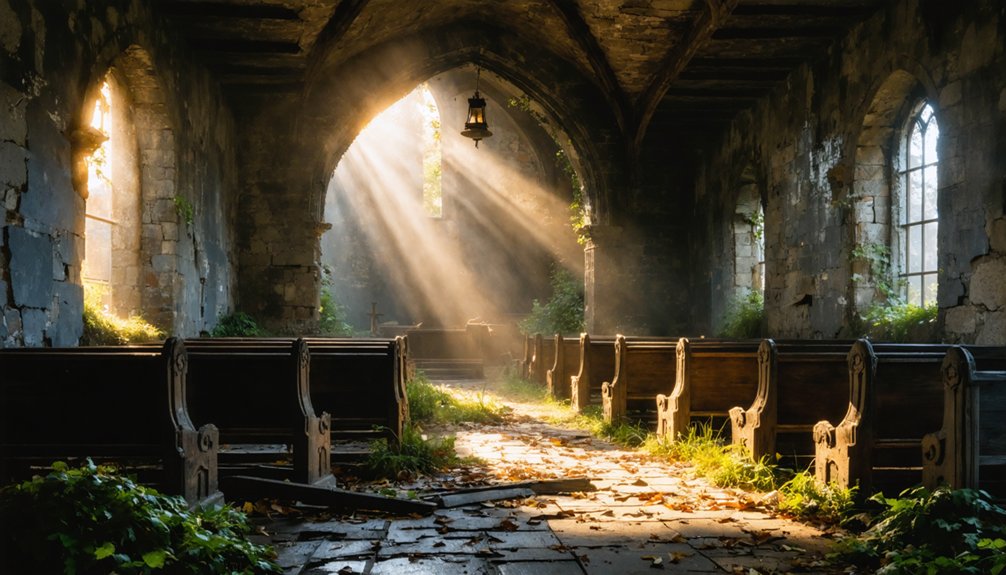
As you explore Belle Plain’s ghostly landscape today, you’ll encounter the striking stone ruins of its once-prestigious college, whose hollow shell stands as evidence to West Texas’s early educational ambitions.
The Baptist foundations that established this cultural centerpiece in the 1870s are evident in both the architectural choices and the prominent music program that once attracted students region-wide.
These religious underpinnings survive physically in the weathered native stone structures—particularly the three-story main building with its distinctive cupola and the dean’s residence—which have outlasted their wooden counterparts through more than a century of abandonment. The college’s renowned music department once housed twelve grand pianos, showcasing the institution’s commitment to arts education. Visitors should exercise caution when exploring these historical remnants due to the presence of dangerous hollow cisterns that pose significant safety risks.
College Ruins Today
Today, the ruins of Belle Plain College stand as silent sentinels to a pioneering educational vision that once flourished in this Texas ghost town. The remnants of this Methodist institution, constructed of native stone, have withstood over a century of abandonment while preserving their architectural integrity.
When you visit, you’ll encounter:
- A rectangular stone structure where the main building once soared three stories high, crowned with a fourth-story cupola
- The dean’s residence, also built from local stone, showing the ravages of time yet remaining structurally intact
- A site that earned Texas Historical Marker recognition in 1969, located approximately one mile east of U.S. Highway 283
These architectural remains embody the college history of West Texas’s earliest higher education experiments. The college once offered classical education with particular emphasis on the arts, representing the cultural aspirations of this frontier community. Financial difficulties arising from a severe drought ultimately led to the college’s closure in 1892, ending Belle Plain’s educational prominence.
Baptist Foundations Remain
Beyond the collegiate stones of Belle Plain College, another foundational institution shaped the town’s cultural landscape. The Baptist heritage established in 1879 continues to echo through Belle Plain’s silent streets.
Originally known as Bell Plain Baptist Church, the congregation first gathered in J.A. Lindsay’s home before constructing their dedicated sanctuary.
This Baptist foundation provided more than spiritual guidance—it offered community cohesion during Belle Plain’s brief prosperity. The church and college formed symbiotic cultural pillars until drought devastated the region in 1886-1887. When the original structure was built in 1884, it stood only briefly before high winds destroyed the church around 1896. Similar to the Independence Baptist Church, this site represents Texas Baptist heritage that played a vital role in early settlement communities.
While the congregation disbanded in 1968, the physical remnants persist on private land.
As you explore Texas ghost towns, you’ll find Baptist churches frequently anchored these frontier communities. Their structural remains and cemeteries serve as historical markers, preserving the religious identity that once defined these abandoned settlements.
The Last Standing Walls: Architectural Features of Ghost Town Churches
Silhouetted against the Texas sky, the architectural remnants of ghost town churches tell stories of faith, ambition, and ultimate abandonment.
These structures showcase diverse architectural styles from adobe construction in West Texas to European-inspired stone masonry and Gothic Revival elements. Despite compromised structural integrity, certain features persist as symbols of frontier craftsmanship.
When exploring these sacred ruins, you’ll encounter:
- Adobe arches and deteriorating walls where light penetrates through eroded mortar joints
- Symmetrical bell towers and thick stone walls reflecting Baroque and mission influences
- Gothic elements including pointed arches and spaces where stained glass once filtered sunlight
These weathered walls represent not failure but perseverance—physical manifestations of communities that thrived before economic shifts rendered them obsolete.
Historical Significance and the Sam Houston Connection

When you visit these silent sentinels of Texas spirituality, you’ll witness the enduring impact of Sam Houston’s historic baptism into the Baptist faith, which occurred amidst a transformative period for Texas religious institutions.
The frontier churches’ persistent stone walls and weathered wooden frames represent faith communities that often outlasted the economic viability of the towns themselves.
Your exploration of these sacred ruins connects you directly to the religious landscape that Houston helped shape through his support of institutions like Baylor University and numerous congregations across the newly formed republic and state.
Houston’s Historic Baptism
Although many historic churches dot the Texas landscape, few hold the cultural and political significance of Independence Baptist Church, where General Sam Houston was baptized in 1854. This pivotal moment in Houston’s life reflects the intertwining of spiritual and political leadership in early Texas.
Houston’s baptism, performed by Reverend Rufus C. Burleson, represents a transformative event in Baptist heritage that’s commemorated to this day:
- The church preserves Houston’s original pew, marked for visitors seeking tangible connections to Texas history.
- The baptismal event occurred simultaneously with Houston joining the congregation, alongside his wife Margaret.
- The church’s affiliation with Baylor University solidified its role in developing Baptist education and ministerial training.
When you visit Independence, you’ll witness how this sacred space transcended mere religious function to shape Texas’s identity.
Frontier Faith Endures
Sam Houston’s baptism at Independence signifies far more than a personal religious milestone—it represents the enduring foundation of frontier faith across Texas.
When you explore abandoned churches in former boomtowns, you’re witnessing physical manifestations of frontier spirituality that outlasted the communities themselves.
Even as towns vanished, their churches often remained—cultural anchors during Texas’s formative years. Houston’s conversion occurred within this context of enduring faith, where Baptist congregations served as hubs for both spiritual growth and political discourse.
His stance against secession reflected moral convictions formed partially through religious influence.
The rugged settings of these frontier churches—like the creek where Houston was baptized after a prankster filled the baptistry with mud—embody the resourceful determination that characterized Texas’s religious landscape, creating a legacy of spiritual resilience despite material hardship.
Churches Outlast Towns
Remarkably, the ecclesiastical structures dotting Texas ghost towns have demonstrated greater longevity than the settlements they once served.
These architectural testimonies withstand time as silent witnesses to vanished communities, many influenced by Sam Houston’s expansion policies. The ghost town architecture reveals cultural heritage through carefully preserved religious edifices that once served thriving populations.
When you explore these abandoned sanctuaries, you’ll find they’ve outlasted their communities for several reasons:
- Sturdy construction methods utilizing local materials designed for permanence
- Continuous maintenance by dedicated former residents and historical societies
- Symbolic importance that transcended mere functionality
Churches frequently remain as the final physical vestiges of towns that peaked in the early 1900s, preserving birth records, wedding certificates, and funeral ledgers—tangible connections to communities that otherwise exist only in memory.
Photographing Texas’s Abandoned Places of Worship
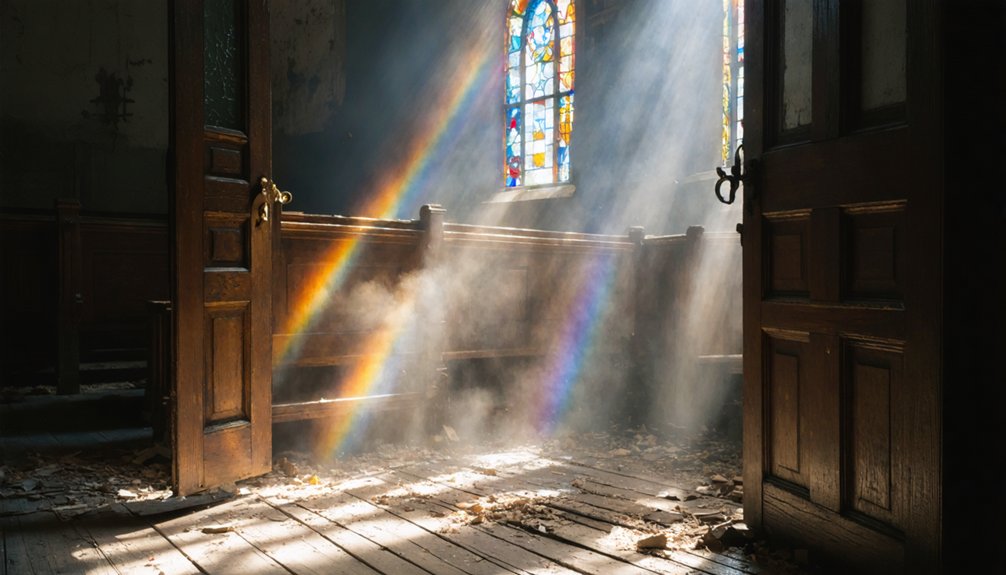
Capturing the silent witnesses of Texas’s frontier past, abandoned churches across the state’s ghost towns offer photographers an unparalleled opportunity to document architectural history through their lenses. The abandoned beauty of sites like Saint Dominic in D’Hanis and Zion Hill Church near Caldwell rewards those who arrive during golden hour, when sunlight filters through collapsed roofs and vacant doorways.
For ideal results, equip yourself with wide-angle lenses for structural compositions and macro equipment for capturing architectural decay in weathered stone and timber. Consider tripods essential for low-light interiors and cemetery scenes.
Remote locations demand preparation—bring water, navigation tools, and research property access beforehand. The juxtaposition of French-German grave markers against stark rural landscapes creates visual narratives that transcend mere documentation, revealing Texas’s multicultural religious heritage.
Preservation Challenges and Community Efforts
Despite their historical significance, abandoned churches throughout Texas’s ghost towns face a multitude of preservation challenges that threaten their continued existence. Weathering elements, unclear property ownership, and limited financial resources create formidable obstacles for conservation efforts.
These forgotten sanctuaries stand at risk, their historical value battling against time, neglect, and bureaucratic limbo.
Community engagement has proven essential in developing effective preservation strategies. You’ll find these grassroots initiatives taking several forms:
- Local historical societies organizing fundraising events and awareness campaigns
- Nonprofit preservation groups like Friends of the Ruidosa Church coordinating volunteer restoration work
- County historical commissions leveraging state and local funding to document and protect sites
When government support aligns with passionate community advocacy, even the most deteriorated structures can be saved. The Texas Historical Commission and National Trust provide critical technical expertise, while adaptive reuse projects offer sustainable paths forward for these architectural treasures.
Cemetery Stories: The Final Resting Places Around Ghost Town Churches
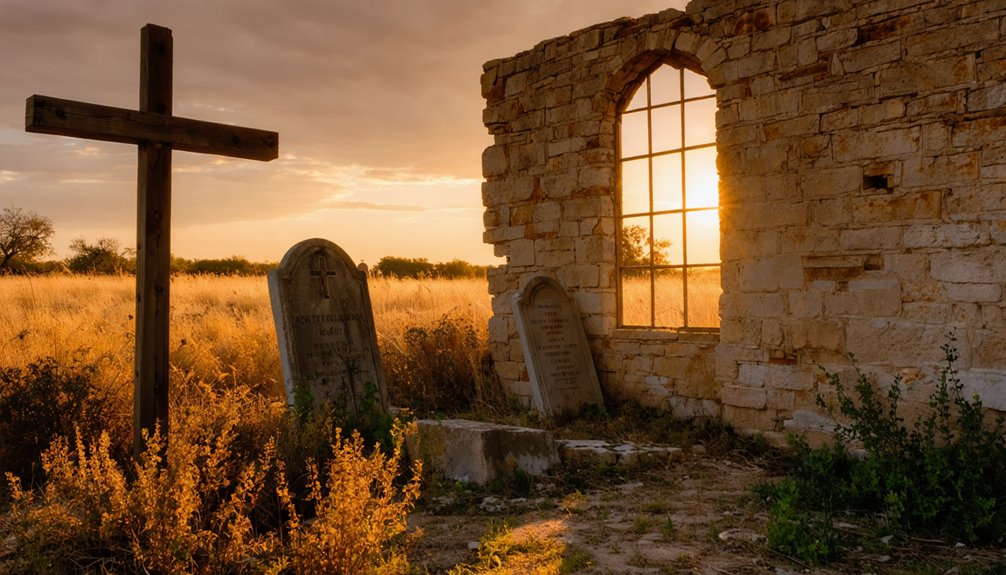
Adjacent to abandoned sanctuaries across Texas ghost towns, cemeteries tell equally compelling stories through weathered tombstones and iron fences.
You’ll find Camptown Cemetery, once a refuge for escaped slaves, now holding over 400 documented interments—its burial rituals preserving African American “home-going” celebrations and cultural identity despite decades of neglect.
Cemetery symbolism varies dramatically across Texas: Sturrock Cemetery displays Scottish cairn-inspired markers, while Paradise Cemetery features cryptic inscriptions reflecting local customs.
Often, these burial grounds outlast their associated churches and towns, becoming sole witnesses to vanished communities like St. Mary’s of Aransas.
These sacred spaces document complex racial histories, scientific contributions, and frontier expansion.
In Shafter’s historically registered cemetery and Huntsville’s prison burial ground, you’ll encounter compelling narratives of marginalized populations whose stories might otherwise have disappeared from Texas’s cultural landscape.
Planning Your Visit: Accessibility and Respectful Exploration
Before starting your ghost town church expedition, you’ll need to navigate a complex landscape of access restrictions and safety considerations that protect both visitors and these fragile historical treasures.
Legal considerations vary considerably across sites—private property requires explicit permission, while public lands may limit access to specific visitor categories.
Essential preparation points:
- Research property status beforehand, as trespassing laws are strictly enforced.
- Prepare for environmental challenges with appropriate vehicles and seasonal gear.
- Document your plans with GPS coordinates and local historical society information.
Safety precautions must address both structural hazards and wildlife encounters.
Abandoned churches often contain compromised foundations, hazardous materials, and wildlife inhabitants.
Remember that these sites represent cultural heritage—your responsible exploration helps preserve these atmospheric windows into Texas’s past.
Frequently Asked Questions
Are There Paranormal Investigation Opportunities at These Abandoned Churches?
Yes, you’ll find ghost hunting opportunities at both churches, with Bomarton’s St. John’s offering formal access through visitor sign-ins, while Terlingua’s St. Agnes provides atmospheric conditions conducive to spiritual experiences.
What Protective Gear Should Visitors Bring to Explore Deteriorating Structures?
You’ll need an N95 respirator, steel-toed boots, protective eyewear, heavy-duty gloves, first aid supplies, and reliable lighting. These safety equipment essentials protect against structural hazards during your freedom-focused exploration adventures.
How Have Weather Patterns Affected Church Preservation Across Different Regions?
You’ll notice regional climate impacts vary dramatically—coastal humidity accelerates decay while inland areas face drought-induced cracking. Modern preservation techniques must adapt to these distinct weather patterns affecting each church’s structural integrity.
Can Visitors Participate in Restoration Volunteer Work?
Imagine adobe clay molding between your fingers as you contribute to history. You can join volunteer opportunities through restoration programs like Friends of the Ruidosa Church, working alongside experts to rebuild Texas’ forgotten spiritual landmarks.
Which Abandoned Churches Allow Interior Access Versus Exterior-Only Viewing?
You can enjoy interior exploration at Bomarton Church, Belcherville Baptist, and Salem Church, while Saint Dominic ruins require exterior photography only. Many ghost town churches need permission for access.
References
- https://en.wikipedia.org/wiki/List_of_ghost_towns_in_Texas
- https://texashighways.com/travel-news/four-texas-ghost-towns/
- https://texasghosttowns.blogspot.com/?m=0
- https://www.county.org/county-magazine-articles/summer-2025/ghost-towns
- https://www.hipcamp.com/journal/camping/texas-ghost-towns/
- https://www.youtube.com/watch?v=Ux4FjzHs5DE
- https://www.atlasobscura.com/things-to-do/texas/ghost-towns
- https://www.texasescapes.com/Texas-Ghost-Towns-A-to-Z.htm
- https://mix931fm.com/texas-ghost-towns-history/
- https://www.mapquest.com/us/texas/ruins-of-st-dominic-catholic-church-779288726

